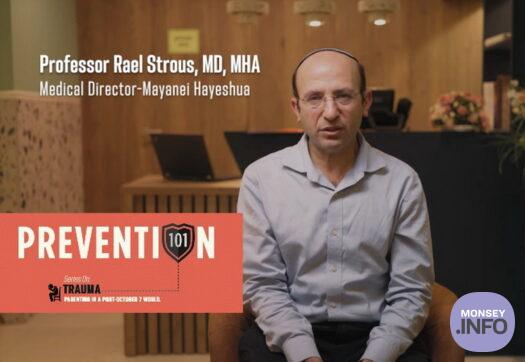
Prevention101: Series on Trauma: Episode #2 – My 13-Year-Old Has Experienced A Notable Increase in Weight since October 7th. What Should I Do?
Series on Trauma: Episode 2 – Parenting in a Post-October 7th World. The series addresses questions regarding trauma following the massacre of October 7th and the surge of global anti-Semitism.
The second question was posed to Prof. Rael Strous, Medical Director of Mayanei Hayeshua’s Mental Health Center.
“My 13-year-old has experienced a notable increase in weight since October 7th. What should I do?”
Each person responds to trauma in a distinct manner influenced by their personality and inherent nature. Because children are still developing their identities, personalities, and coping skills, they may exhibit dysfunctional responses.
One possibility is a child overeating when dealing with trauma. Being exposed to trauma or news of trauma is often like going through it oneself. Even if a person hasn’t been exposed to the trauma themselves, knowing someone who has gone through it or constantly hearing about it from people who are close to them can make it seem almost as if they’ve gone through it themselves.
Sometimes, all the symptoms of post-traumatic stress disorder (PTSD) can be manifested in very close family members of those who’ve gone through trauma themselves. Any child who hears about trauma or was exposed to trauma has experienced a form of loss of control. This loss of control can be manifested in many different ways, such as overeating, aggression, withdrawal, or engaging in unsafe activities.
As parents or responsible adults, it’s important to assist children in reclaiming control over their lives by being sensitive to their current state, acknowledging the difficulty of their experience, validating their responses even if they’re dysfunctional at the moment, and guiding them back onto a positive path. Now, how can we do that?
An essential aspect, both in the immediate aftermath of acute trauma and in its long-term effects, is supporting our children in re-establishing a sense of routine. We go to sleep at a certain time, we eat at a certain time, and we need to be at school at a certain time. This is an infrastructure or what we call the “seder hayom”- the makeup of our day that must be kept. Keep the routine, keep the times, and then everything else fits into and around it. Once the routine is established, we can better assist them in coping and guide them back to their usual activities and functions. Routine acts as a comforting anchor for children, helping them regain a sense of security and normalcy during challenging times.
We should never lie to children by saying that things are not happening when they are indeed happening. At the same time we can say, “Okay, we still need to manifest and do what we are supposed to do.” For example, when I’m called in a rush to the safe room with my family, I have something I do. I’ve done this for many, many years since my children were very young, and even though the children have grown up and are at different ages, they still associate the safe room and running to the safe room with a positive experience.
While rushing to the safe room certainly is not an ideal situation, the safe room isn’t associated with trauma, anxiety, distress, and fear because there’s also that positive side to it. I’m very open with the children by saying, “Okay, we need to run to the safe room because our life is in danger,” at the same time, what do you do with anxiety and distress? “We are now going to sit down, and we’re going to eat chocolate together.” That safe room now gets associated with some kind of positive experience.
When children face challenging experiences,- and there’s a range of different experiences they can go through – it’s often hard to find a direct positive association. However, one positive connection we can make is acknowledging their struggle and offering support without pressure, saying, “You’ve gone through a difficult thing, and I see that. Let’s go for a walk; let’s go spend some time together. You don’t have to talk about it, but I’m here for you.”
One of the most important ways to deal with acute stress today is, first, to normalize what the person is experiencing. We can say, “Right now you are overeating because maybe you were exposed to this thing.” Normalize it, it’s okay. Next, validate what they’ve gone through and their response. “That is an approach, but maybe we can look and see how it’s affecting your function in a negative way. Maybe there’s a better way to deal with things right now.” At no point have we mentioned or spoken with the child about the trauma itself, what the trauma was about, and what the child went through.
While those are all important, our primary focus lies in their functioning. At this stage, other factors take a backseat as we prioritize their ability to function. If the child feels prepared to broach the topic of the trauma, we’ll approach it, but solely if they initiate the conversation and feel ready. Before any of that, we must normalize, validate, and move on with hope.
Prof. Strous, MD, MHA, is a Professor of Psychiatry at the Faculty of Medicine of Tel Aviv University, editor-in-chief of the Israel Journal of Psychiatry, and the chairman of the ethics committee of the Israel Psychiatry Association









